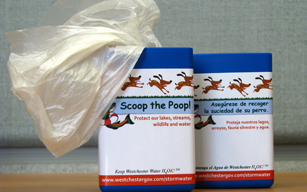Pet Waste
 Pet waste is NOT fertilizer!
Pet waste is NOT fertilizer!
In fact, it can be a major source of bacteria and excess nutrients in local waters. Leaving pet waste on the ground increases public health risks by allowing harmful bacteria and nutrients to wash into the storm drain and eventually into local waterbodies.
What can you do?
- Carry a pooper scooper or plastic bags.
- Flush it down a toilet, as long as it’s not mixed with litter or other materials. This is the best method because your septic system or community sewage plant will treat the waste.
- Or seal the waste in a plastic bag and put it in the garbage.
- Never dump pet waste or plastic bags containing waste into a storm drain.
If your community does not regulate pet waste, encourage your local government to adopt a “pooper-scooper” ordinance.
If your local parks do not provide pet waste stations, encourage them to do so. In some parts of the country, the concept of parks or portions of parks established specifically for urban dog owners has gained in popularity. With provisions for proper disposal of dog feces and design to address stormwater runoff, these parks may represent another option for protecting local water quality.
Did you know?
According to recent research, non-human waste represents a significant source of bacterial contamination in urban watersheds. Genetic studies by Alderiso et al. (1996) and Trial et al. (1993) both concluded that 95 percent of the fecal coliform found in urban stormwater was of non-human origin.
It has been estimated that for watersheds of up to twenty-square miles draining to small coastal bays, two to three days of droppings from a population of about 100 dogs would contribute enough bacteria and nutrients to temporarily close a bay to swimming and shellfishing (US EPA, 1993).
Pet waste can also be a factor in eutrophication of lakes. The release of nutrients from the decay of pet waste promotes weed and algae growth, limiting light penetration and the growth of aquatic vegetation. This in turn can reduce oxygen levels in the water, affecting fish and other aquatic organisms.
Residents seem to be of two minds when it comes to dog waste. While a strong majority agrees that dog waste can be a water quality problem (Hardwick, 1997; Swann, 1999), they generally rank it as the least important local water quality problem (Syferd, 1995 and MCSR, 1997).